Bird R.B., Stewart W.E., Lightfoot E.N. Transport Phenomena
Подождите немного. Документ загружается.

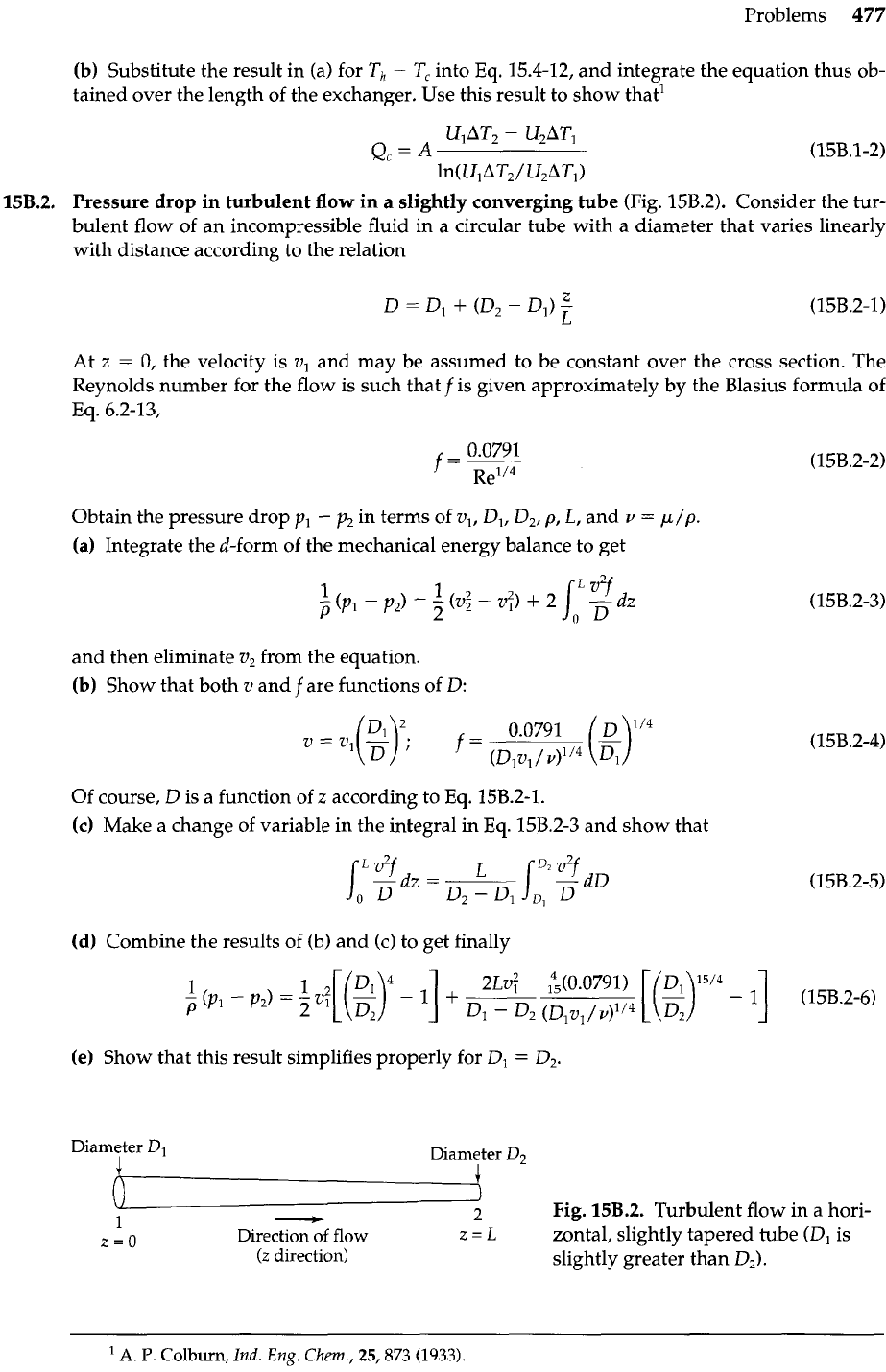
Problems
477
(b) Substitute the result in (a) for
T,,
-
T,
into Eq. 15.4-12, and integrate the equation thus ob-
tained over the length of the exchanger. Use this result to show that1
15B.2.
Pressure drop in turbulent flow in
a
slightly converging tube (Fig. 15B.2). Consider the tur-
bulent flow of an incompressible fluid in a circular tube with a diameter that varies linearly
with distance according to the relation
At
z
=
0,
the velocity is
v,
and may be assumed to be constant over the cross section. The
Reynolds number for the flow is such that
f
is given approximately by the Blasius formula of
Eq. 6.2-13,
Obtain the pressure drop
p,
-
p2
in terms of
v,,
D,,
D,,
p,
L,
and
v
=
p/p.
(a)
Integrate the d-form of the mechanical energy balance to get
and then eliminate
v,
from the equation.
(b) Show that both
v
and
f
are functions of
D:
Of
course,
D
is a function of
z
according to Eq. 158.2-1.
(c)
Make a change of variable in the integral in Eq. 15B.2-3 and show that
(d) Combine the results of (b) and
(c)
to get finally
(e)
Show that this result simplifies properly for
Dl
=
D,.
Diameter
Dl
I
Diameter
D2
I
u
I
1
-
2
Fig.
15B.2.
Turbulent flow in a hori-
z=O
Direction
of
flow
z
=
L
zontal, slightly tapered tube
(Dl
is
(Z
direction)
slightly greater than
D,).
'
A.
P.
Colburn,
Ind.
Eng.
Chem.,
25,873 (1933).
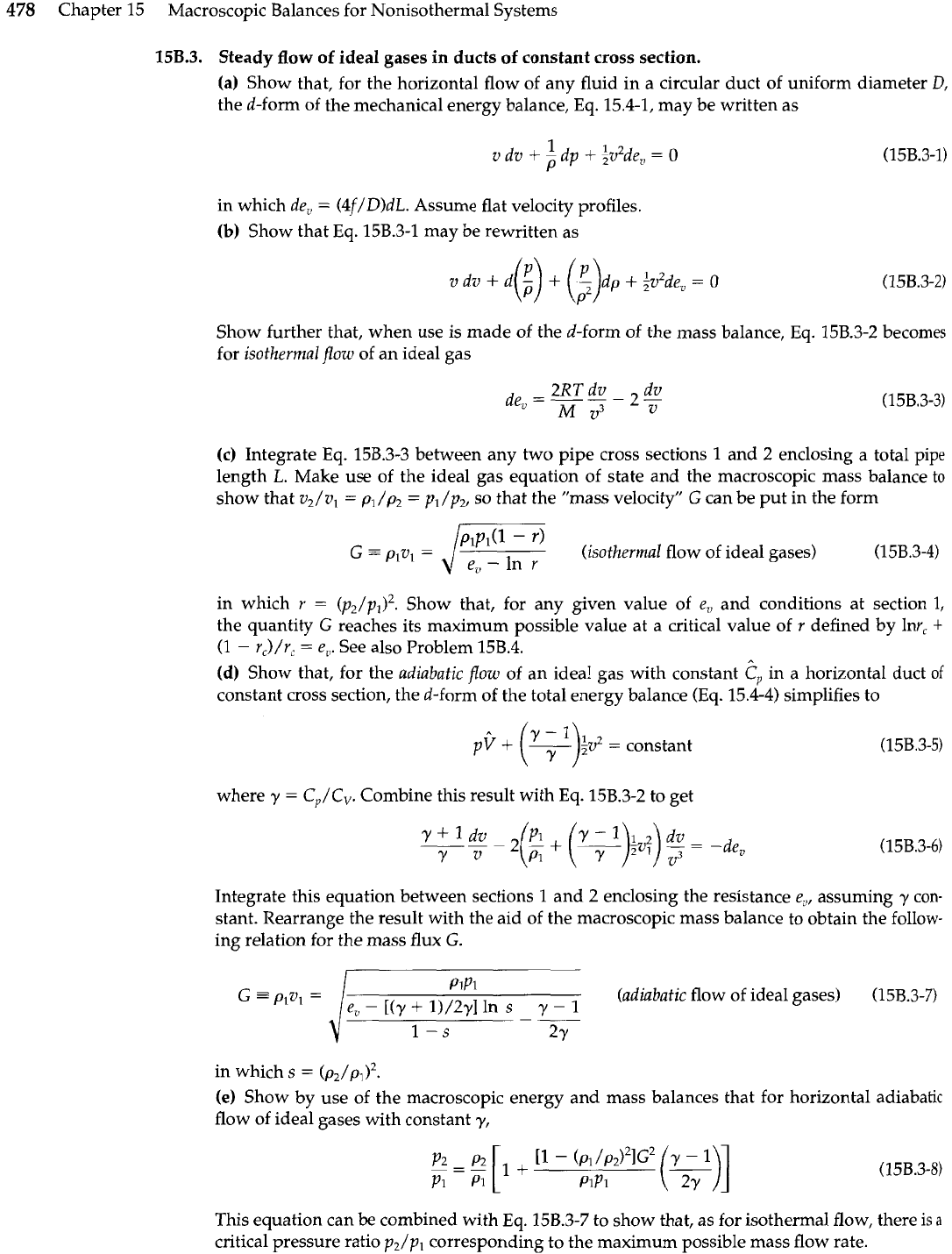
478
Chapter 15 Macroscopic Balances for Nonisothermal Systems
15B.3.
Steady flow
of
ideal gases
in
ducts of constant
cross
section.
(a)
Show that, for the horizontal flow of any fluid in a circular duct of uniform diameter
D,
the d-form of the mechanical energy balance,
Eq.
15.4-1, may be written as
in which de,
=
(4f/D)dL. Assume flat velocity profiles.
(b)
Show that
Eq.
15B.3-1 may be rewritten as
Show further that, when use is made of the d-form of the mass balance, Eq. 15B.3-2 becomes
for isothermal flow of an ideal gas
2RTdv dv
de,
=
--
-
M
v3
2u
(c)
Integrate Eq. 15B.3-3 between any two pipe cross sections
1
and
2
enclosing a total pipe
length
L.
Make use of the ideal gas equation of state and the macroscopic mass balance
to
show that vJv1
=
pl/p2
=
pI/p2,
SO
that the "mass velocity"
G
can be put in the form
J
plpl(1
-
r)
G
=
plvl
=
(isothermal flow of ideal gases) (158.3-4)
e,
-
In
r
in which
r
=
(p2/p,I2. Show that, for any given value of e, and conditions at section
1,
the quantity
G
reaches its maximum possible value at a critical value of
r
defined by Inr,
t
(1
-
T,)/Y,
=
e,,. See also Problem 15B.4.
(d)
Show that, for the adiabatic
flow
of an ideal gas with constant
4
in a horizontal duct
of
constant cross section, the d-form of the total energy balance
(Eq.
15.4-4) simplifies to
+
(G)$v2
=
constant
where
y
=
C,/CV. Combine this result with Eq. 15B.3-2 to get
Integrate this equation between sections
1
and
2
enclosing the resistance e,, assuming
y
con-
stant. Rearrange the result with the aid of the macroscopic mass balance to obtain the follow-
ing relation for the mass
flux
G.
PlPl
G
=
plvl
=
(adiabatic flow of ideal gases) (15B.3-7)
in which s
=
(p2/p,)2.
(e)
Show by use of the macroscopic energy and mass balances that for horizontal adiabatic
flow of ideal gases with constant 7,
p2
-
p2 1
+
---[
[l
-
(PI/PZ)~IG~
(y2;
1
j]
Pl
PI
PlPl
This equation can be combined with Eq. 158.3-7 to show that, as for isothermal flow, there
is
a
critical pressure ratio p2/pI corresponding to the maximum possible mass flow rate.
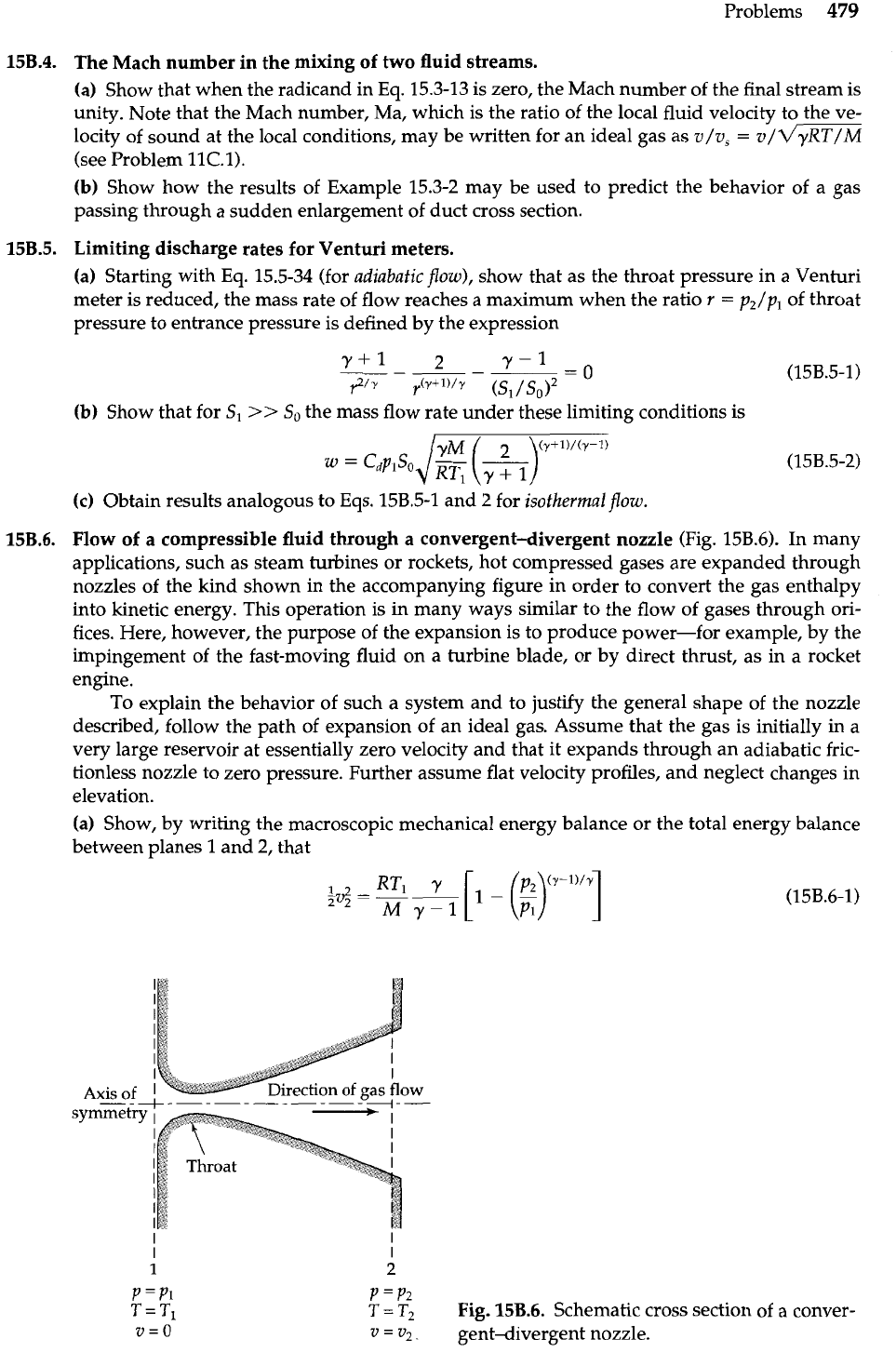
Problems
479
15B.4.
The Mach number in the mixing of two fluid streams.
(a)
Show that when the radicand
in
Eq.
15.3-13 is zero, the Mach number of the final stream is
unity. Note that the Mach number, Ma, which is the ratio of the local fluid velocity to the ve-
locity of sound at the local conditions, may be written for an ideal gas as
v/v,
=
v/m
(see Problem 11C.1).
(b)
Show how the results of Example 15.3-2 may be used to predict the behavior of a gas
passing through a sudden enlargement of duct cross section.
15B.5.
Limiting discharge rates
for
Venturi meters.
(a)
Starting with
Eq.
15.5-34 (for adiabatic flow), show that as the throat pressure in a Venturi
meter is reduced, the mass rate of flow reaches a maximum when the ratio r
=
p,/p,
of throat
pressure to entrance pressure is defined
by
the expression
(b)
Show that for
S1
>>
So
the mass flow rate under these limiting conditions is
(c)
Obtain results analogous to Eqs. 15B.5-1 and 2 for isothermal pow.
15B.6.
Flow of a compressible fluid through
a
convergent-divergent nozzle
(Fig. 15B.6). In many
applications, such as steam turbines or rockets, hot compressed gases are expanded through
nozzles of the kind shown in the accompanying figure in order to convert the gas enthalpy
into kinetic energy. This operation is
in
many ways similar to the flow of gases through ori-
fices. Here, however, the purpose of the expansion is to produce power-for example, by the
impingement of the fast-moving fluid on a turbine blade, or by direct thrust, as in a rocket
engine.
To explain the behavior of such a system and to justlfy the general shape of the nozzle
described, follow the path of expansion of an ideal gas. Assume that the gas is initially in a
very large reservoir at essentially zero velocity and that it expands through an adiabatic fric-
tionless nozzle to zero pressure. Further assume flat velocity profiles, and neglect changes in
elevation.
(a)
Show, by writing the macroscopic mechanical energy balance or the total energy balance
between planes
1
and 2, that
I
I
I
I
I
I
I
I
irection
of
gas
flow
Ax%!-!-
-.-
symmetry
;
I
I
I
I
I
I
I
I
P
=
P2
T
=
T,
Fig.
15B.6.
Schematic cross section of a conver-
0
=
4.
gent-divergent nozzle.
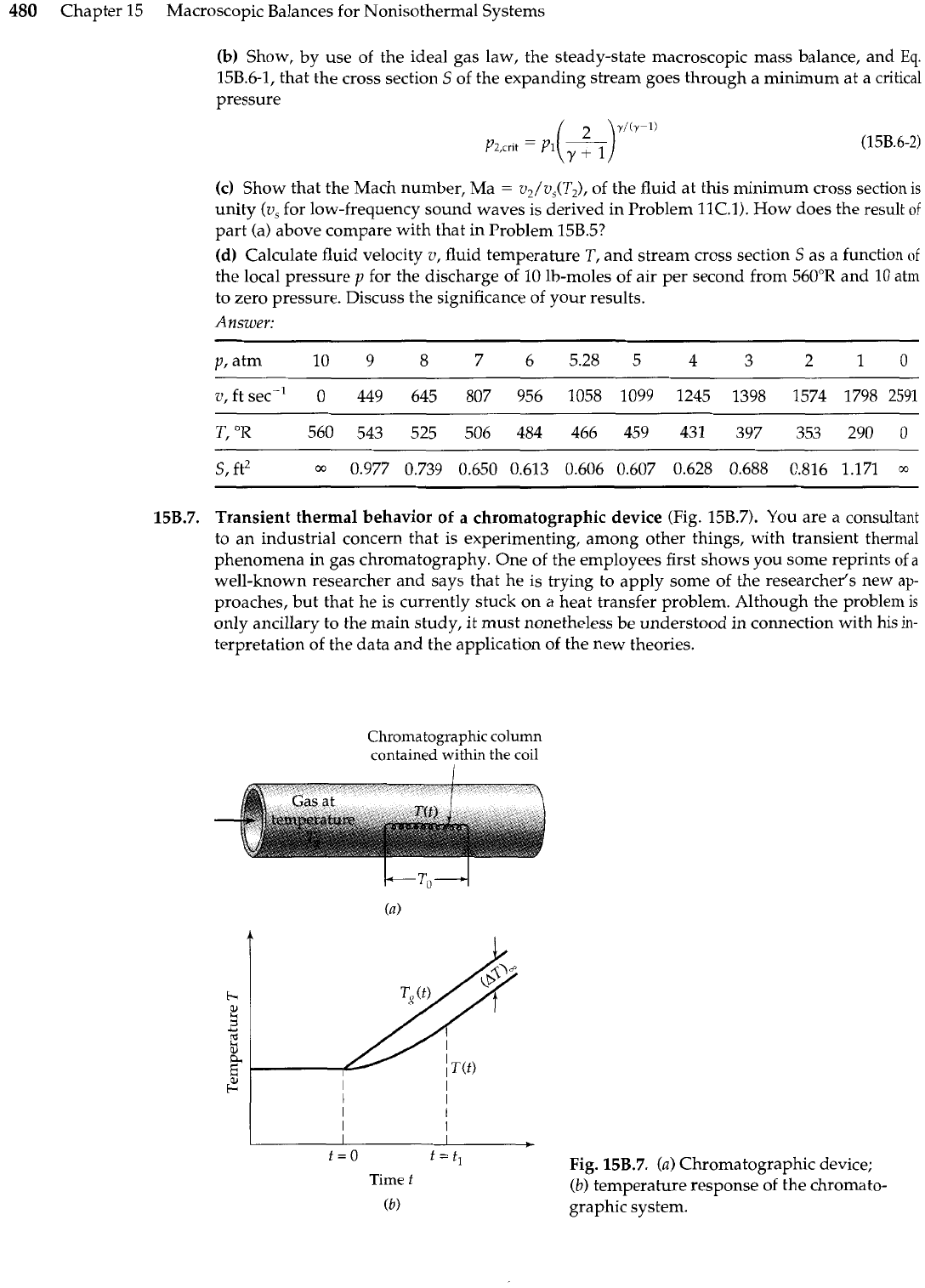
480
Chapter 15 Macroscopic Balances for Nonisothermal Systems
(b)
Show, by use of the ideal gas law, the steady-state macroscopic mass balance, and
Eq.
15B.6-1, that the cross section
S
of the expanding stream goes through a minimum at a critical
pressure
(c)
Show that the Mach number, Ma
=
v2/v,(T2), of the fluid at this minimum cross section
is
unity
(u,
for low-frequency sound waves is derived in Problem llC.l). How does the result
of
part (a) above compare with that in Problem 15B.5?
(d)
Calculate fluid velocity
v,
fluid temperature
T,
and stream cross section
S
as a function
of
the local pressure
p
for the discharge of 10 lb-moles of air per second from 560°R and 10 atm
to zero pressure. Discuss the significance of your results.
Answer:
15B.7.
Transient thermal behavior of
a
chromatographic device
(Fig. 15B.7). You are a consultant
to an industrial concern that is experimenting, among other things, with transient thermal
phenomena in gas chromatography. One of the employees first shows you some reprints
of
a
well-known researcher and says that he is trying to apply some of the researcher's new
ap-
proaches, but that he is currently stuck on a heat transfer problem. Although the problem
is
only ancillary to the main study, it must nonetheless
be
understood in connection with his in-
terpretation of the data and the application of the new theories.
Chromatographic column
contained within the coil
A
I
I
I
I I
I
I
I
I
I I
+
t=O
t
=
t,
Fig.
15B.7.
(a)
Chromatographic device;
Time
f
(b)
temperature response of the chromato-
(b)
graphic system.
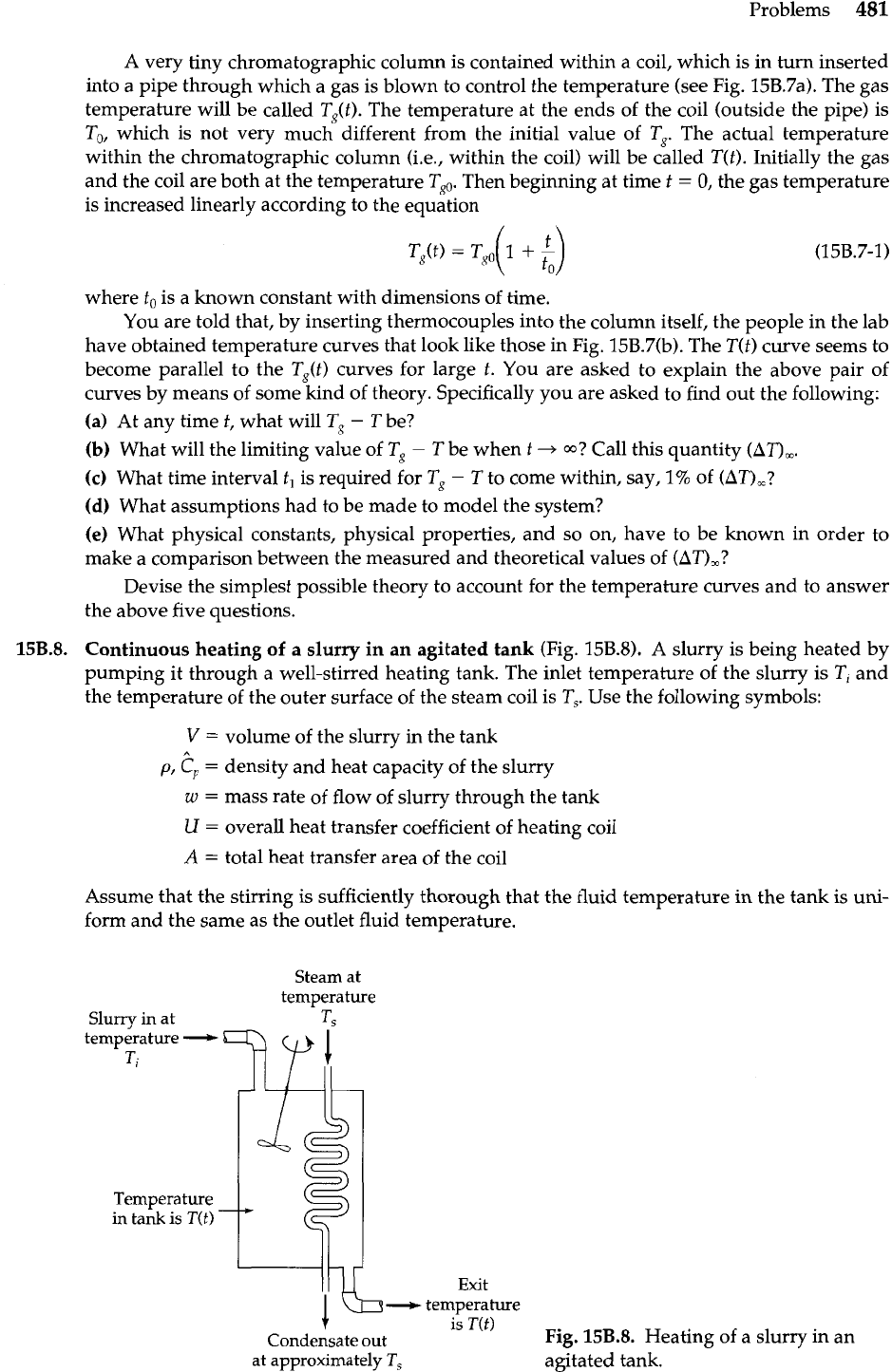
Problems
481
A very tiny chromatographic column is contained within a coil, which is in
turn
inserted
into a pipe through which a gas is blown to control the temperature (see Fig. 15B.7a). The gas
temperature will be called T&t). The temperature at the ends of the coil (outside the pipe) is
To, which is not very much different from the initial value of T,. The actual temperature
within the chromatographic column (i.e., within the coil) will be called T(t). Initially the gas
and the coil are both at the temperature
T8.
Then beginning at time t
=
0,
the gas temperature
is increased linearly according to the equation
where
to
is a known constant with dimensions of time.
You are told that, by inserting thermocouples into the column itself, the people in the lab
have obtained temperature curves that look like those in Fig. 15B.7(b). The T(t) curve seems to
become parallel to the T&t) curves for large
t.
You are asked to explain the above pair of
curves by means of some kind of theory. Specifically you are asked to find out the following:
(a) At any time
t,
what will Tg
-
T be?
(b)
What will the limiting value of T,
-
T be when
t
+
m?
Call this quantity (AT),.
(c)
What time interval
t,
is required for
T,
-
T
to come within, say,
1%
of
(AT),?
(d)
What assumptions had to be made to model the system?
(e) What physical constants, physical properties, and so on, have to be known in order to
make a comparison between the measured and theoretical values of (AT),?
Devise the simplest possible theory to account for the temperature curves and to answer
the above five questions.
15B.8.
Continuous heating of
a
slurry
in an agitated tank (Fig. 15B.8).
A
slurry is being heated by
pumping it through a well-stirred heating tank. The inlet temperature of the slurry is Ti and
the temperature of the outer surface of the steam coil is
T,.
Use the following symbols:
V
=
volume of the slurry in the tank
A
p,
C,
=
density and heat capacity of the slurry
w
=
mass rate of flow of slurry through the tank
U
=
overall heat transfer coefficient of heating coil
A
=
total heat transfer area of the coil
Assume that the stirring is sufficiently thorough that the fluid temperature in the tank is uni-
form and the same as the outlet fluid temperature.
Steam at
temperature
Slurrv
in
at
T,
temperature
-
Ti
Temperature
in
tank
is
T(t)
Exit
-
temperature
Condensate out
is
T(f)
Fig.
158.8.
Heating of a slurry in an
at approximately
T,
agitated tank.
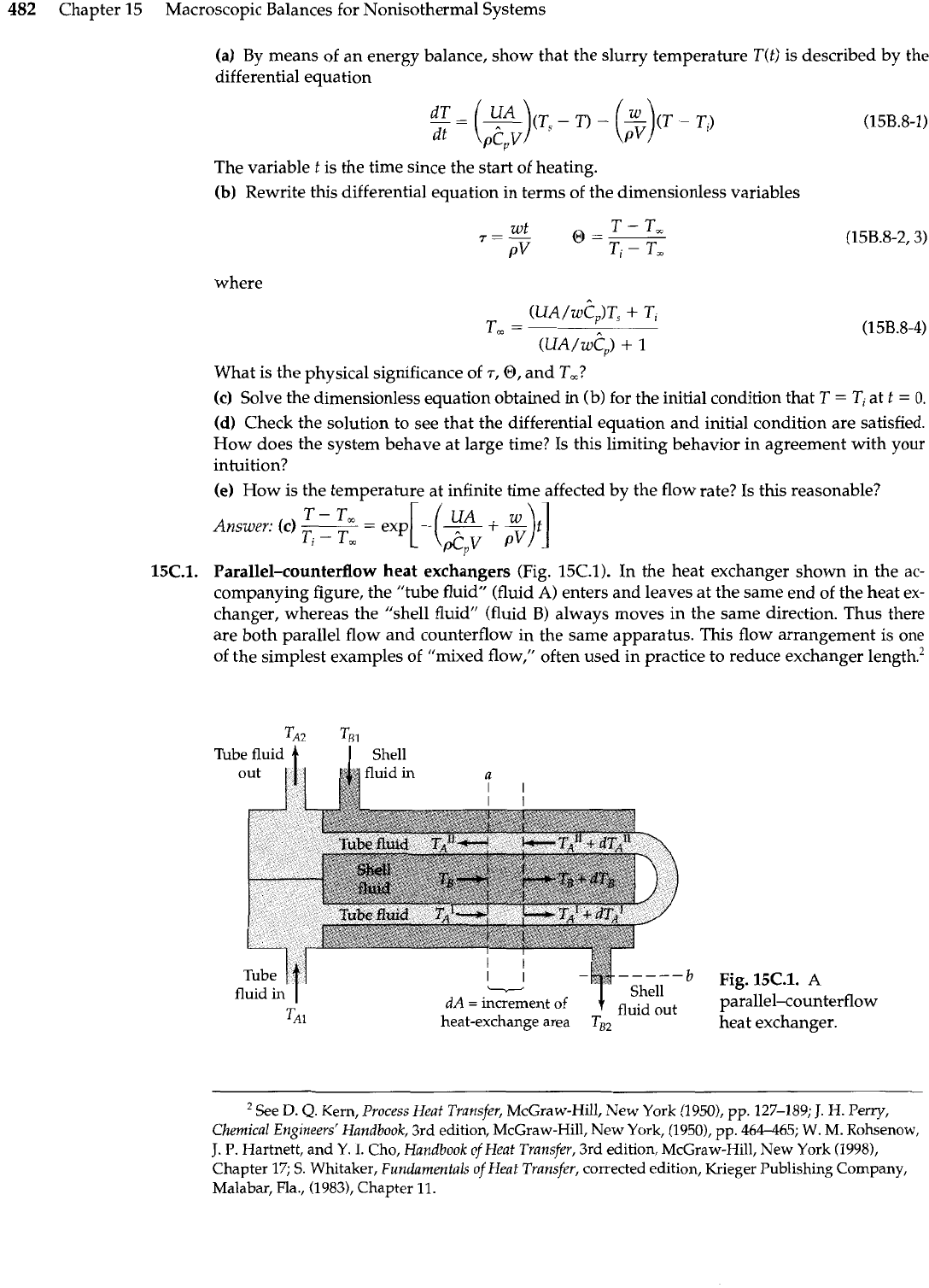
482
Chapter
15
Macroscopic Balances for Nonisothermal Systems
(a)
By means of an energy balance, show that the slurry temperature
differential equation
T(t) is described by the
(15B.8-1)
The variable
t
is the time since the start of heating.
(b)
Rewrite this differential equation in terms of the dimensionless variables
where
What is the physical significance of
T,@,
and T,?
(c)
Solve the dimensionless equation obtained in (b) for the initial condition that
T
=
Ti
at t
=
0.
(d)
Check the solution to see that the differential equation and initial condition are satisfied.
How does the system behave at large time? Is this limiting behavior in agreement with your
intuition?
(e)
How is the temperature at infinite time affected by the flow rate? Is this reasonable?
-
"
-
exy[-(~
+
E)~]
Answer:
(c)
------
-
Ti
-
T,
&V
pV
Parallel-counterflow heat exchangers
(Fig. 15C.1). In the heat exchanger shown in the
ac-
companying figure, the "tube fluid" (fluid A) enters and leaves at the same end of the heat ex-
changer, whereas the "shell fluid (fluid
B)
always moves in the same direction. Thus there
are both parallel flow and counterflow in the same apparatus. This flow arrangement
is
one
of the simplest examples of "mixed flow," often used in practice to reduce exchanger length.'
T~2
T~l
Tube fluid
4
I
Shell
out
a
I
I
I
I
I
I I I
74
-
-----
-
Shell
dA
=
increment of
fluid out
heat-exchange area
TB2
Fig.
l5C.1.
A
parallel-counterflow
heat exchanger.
See
D.
Q.
Kern,
Process Heat Transfer,
McGraw-Hill,
New
York (1950),
pp.
127-189;
J.
H. Perry,
Chemical Engineers' Handbook,
3rd edition, McGraw-Hill, New York, (1950),
pp.
464-465;
W.
M.
Rohsenow,
J.
P. Hartnett, and
Y.
I.
Cho,
Handbook of Heat Transfer,
3rd edition, McGraw-Hill, New York (19981,
Chapter
17;
S.
Whitaker,
Fundamentals of Heat Transfer,
corrected edition, Krieger Publishing Company,
Malabar, Fla., (1983), Chapter 11.
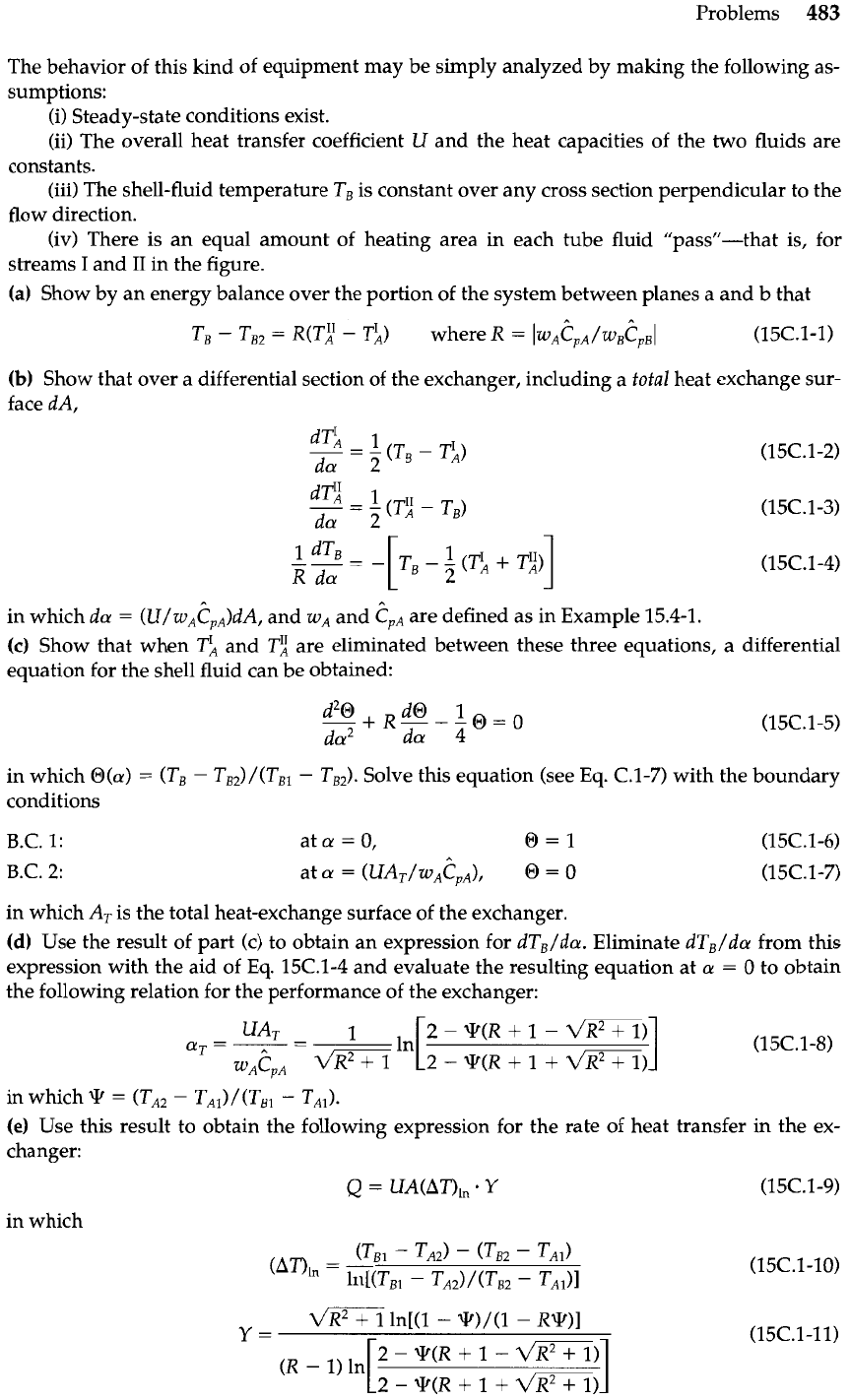
Problems
483
The behavior of this kind of equipment may be simply analyzed by making the following as-
sumptions:
(i) Steady-state conditions exist.
(ii) The overall heat transfer coefficient U and the heat capacities of the two fluids are
constants.
(iii) The shell-fluid temperature TB is constant over any cross section perpendicular to the
flow direction.
(iv) There is an equal amount of heating area
in
each tube fluid "passu-that is, for
streams
I
and
I1
in the figure.
(a)
Show by an energy balance over the portion of the system between planes a and b that
TB
-
T,,
=
R(T~
-
T;)
where
R
=
IW~~~/W~~~~I
(15c.1-1)
(b)
Show that over
a
differential section of the exchanger, including a
total
heat exchange sur-
face dA,
dTi
-
I (TB
-
Ti)
da
2
in which da
=
(U/wAtPA)d~, and
WA
and
epA
are defined as in Example 15.4-1.
(c)
Show that when Ti and
T;
are eliminated between these three equations, a differential
equation for the shell fluid can be obtained:
in which
@(a)
=
(TB
-
TB2)/(TB,
-
TB2). Solve this equation (see Eq. C.l-7) with the boundary
conditions
B.C.
1:
B.C. 2:
in which
A,
is the total heat-exchange surface of the exchanger.
(dl
Use the result of part (c) to obtain an expression for dTB/da. Eliminate dTB/da from this
expression with the aid
of
Eq.
15C.1-4 and evaluate the resulting equation at
a
=
0
to obtain
the following relation for the performance of the exchanger:
in which
=
(TA2
-
TAl)/(TBl
-
TAl).
(e)
Use this result to obtain the following expression for the rate of heat transfer in the ex-
changer:
in which
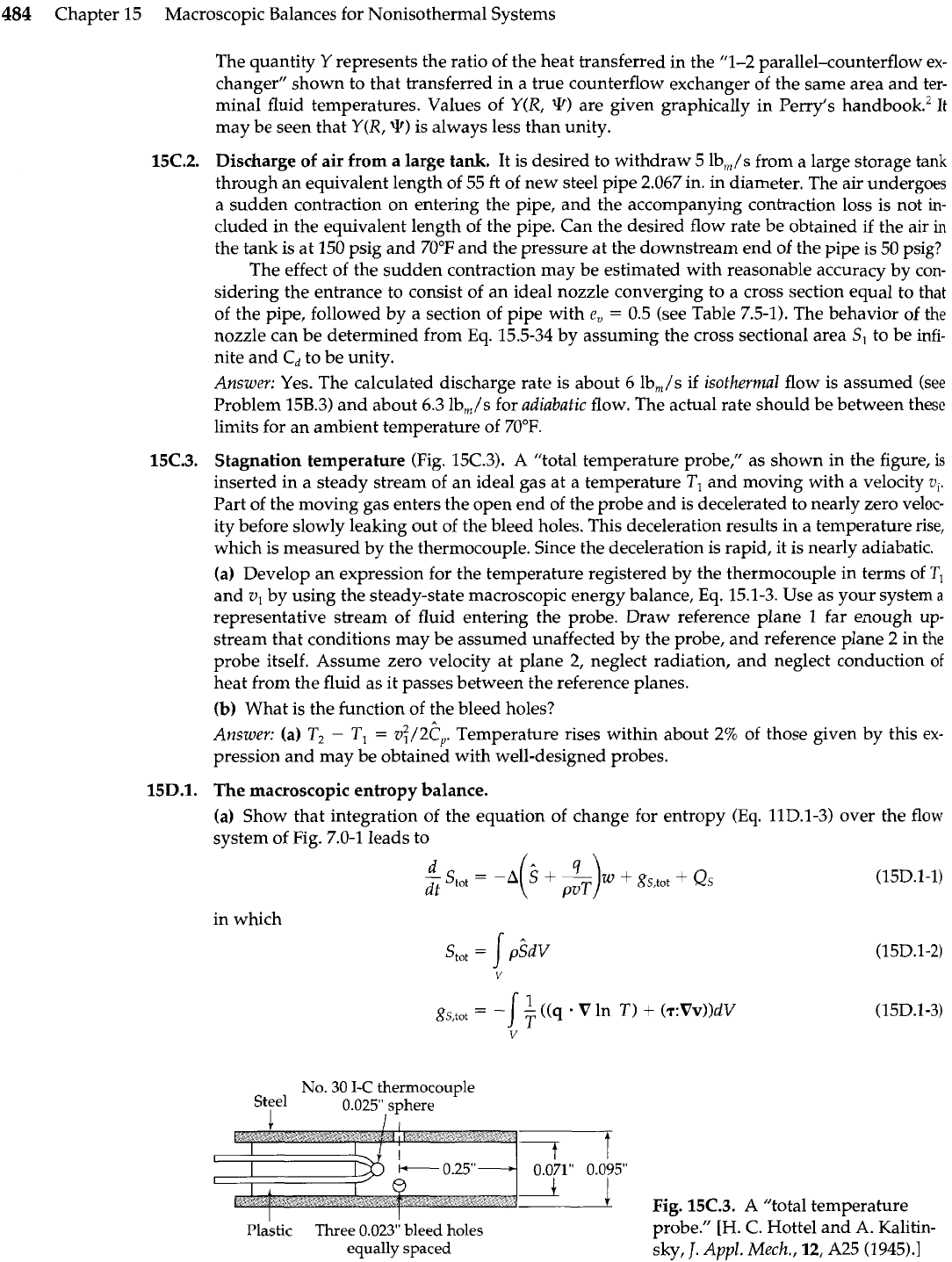
484
Chapter
15
Macroscopic Balances for Nonisothermal Systems
The quantity
Y
represents the ratio of the heat transferred in the
"1-2
parallel-counterflow ex-
changer" shown to that transferred in a true counterflow exchanger of the same area and ter-
minal fluid temperatures. Values of Y(R,
W
are given graphically in Perry's handbook.'
It
may be seen that Y(R,
q)
is always less than unity.
Discharge of air from a large tank. It is desired to withdraw
5
Ib,,/s from a large storage tank
through an equivalent length of
55
ft of new steel pipe
2.067
in. in diameter. The air undergoes
a
sudden contraction on entering the pipe, and the accompanying contraction loss is not
in-
cluded in the equivalent length of the pipe. Can the desired flow rate be obtained if the air
in
the tank is at
150
psig and
70°F
and the pressure at the downstream end of the pipe is
50
psig?
The effect of the sudden contraction may be estimated with reasonable accuracy by con-
sidering the entrance to consist of an ideal nozzle converging to a cross section equal to that
of the pipe, followed by a section of pipe with
e,
=
0.5
(see Table
7.5-1).
The behavior of the
nozzle can be determined from
Eq.
15.5-34
by assuming the cross sectional area S, to be infi-
nite and
Cd
to be unity.
Answer: Yes. The calculated discharge rate is about
6
1bJs if isothermal flow is assumed (see
Problem
15B.3)
and about
6.3
lb,/s for adiabatic flow. The actual rate should be between these
limits for an ambient temperature of
70°F.
Stagnation temperature (Fig.
15C.3).
A
"total temperature probe," as shown in the figure, is
inserted in a steady stream of an ideal gas at a temperature
T,
and moving with a velocity
v,.
Part of the moving gas enters the open end of the probe and is decelerated to nearly zero veloc-
ity before slowly leaking out of the bleed holes. This deceleration results in a temperature rise,
which is measured by the thermocouple. Since the deceleration is rapid, it is nearly adiabatic.
(a) Develop an expression for the temperature registered by the thermocouple in terms of
T,
and
v,
by using the steady-state macroscopic energy balance,
Eq.
15.1-3.
Use as your system
a
representative stream of fluid entering the probe. Draw reference plane
1
far enough
up-
stream that conditions may be assumed unaffected by the probe, and reference plane
2
in the
probe itself. Assume zero velocity at plane
2,
neglect radiation, and neglect conduction
of
heat from the fluid as it passes between the reference planes.
(b)
What is the function of the bleed holes?
Answer: (a)
&
-
TI
=
v;?/2c
Temperature rises within about
2%
of those given by this ex-
pression and may be obtained with well-designed probes.
The macroscopic
entropy
balance.
(a) Show that integration of the equation of change for entropy (Eq.
llD.l-3)
over the flow
system of Fig.
7.0-1
leads to
in which
Stot
=
No. 30
I-C
thermocouple
Steel
I
0.025" sphere
5
0.071" 0.095"
4
Fig.
15C.3.
A
"total temperature
Plastic
Three 0.023" bleed holes
probe."
[H.
C.
Hottel and
A.
Kalitin-
equally
spaced
sky,
J.
Appl.
Mech., 12,
A25 (1945).]
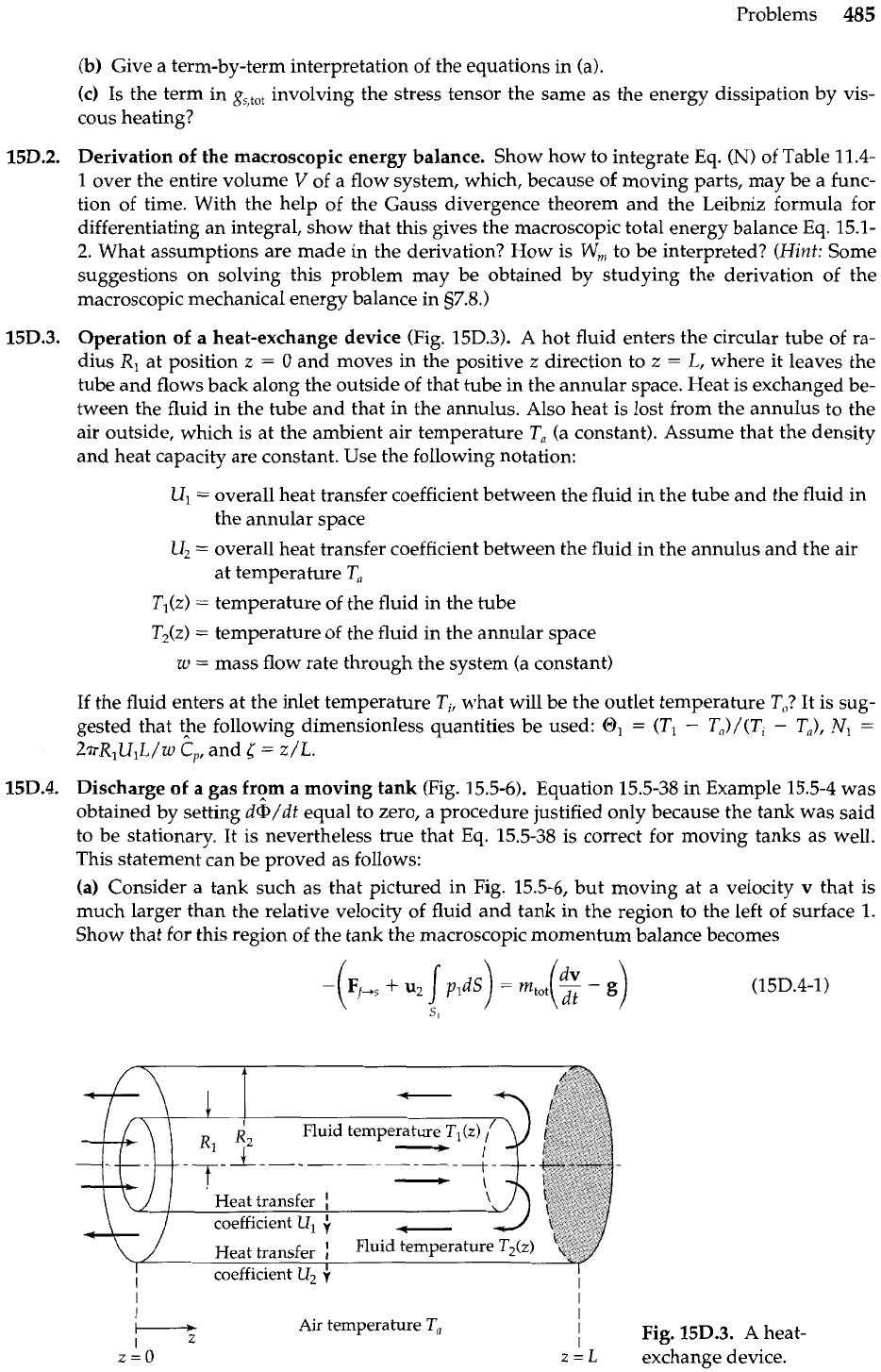
Problems
485
(b)
Give a term-by-term interpretation of the equations in (a).
(c)
IS the term in
g,,,,
involving the stress tensor the same as the energy dissipation by vis-
cous heating?
Derivation
of
the macroscopic energy balance. Show how to integrate Eq.
(N)
of Table 11.4-
1 over the entire volume
V
of a flow system, which, because of moving parts, may be a func-
tion of time. With the help of the Gauss divergence theorem and the Leibniz formula for
differentiating an integral, show that this gives the macroscopic total energy balance
Eq.
15.1-
2.
What assumptions are made in the derivation? How is
W,
to be interpreted?
(Hint:
Some
suggestions on solving this problem may be obtained by studying the derivation of the
macroscopic mechanical energy balance in 97.8.)
Operation of
a
heat-exchange device (Fig. 15D.3).
A
hot fluid enters the circular tube of ra-
dius R, at position z
=
0
and moves in the positive z direction to
z
=
L,
where it leaves the
tube and flows back along the outside of that tube in the annular space. Heat is exchanged be-
tween the fluid in the tube and that in the annulus. AIso heat is lost from the annulus to the
air outside, which is at the ambient air temperature T, (a constant). Assume that the density
and heat capacity are constant. Use the following notation:
Ul
=
overall heat transfer coefficient between the fluid in the tube and the fluid in
the annular space
LI,
=
overall heat transfer coefficient between the fluid in the annulus and the air
at temperature T,
Tl(z)
=
temperature of the fluid in the tube
T2(z)
=
temperature of the fluid in the annular space
w
=
mass flow rate through the system (a constant)
If the fluid enters at the inlet temperature Ti, what will be the outlet temperature T,? It is sug-
gested that t$e following dimensionless quantities be used:
0,
=
(TI
-
T,)/(T,
-
T,),
Nl
=
2nRlUlL/w
Cp,
and
5
=
z/L.
Discharge of a gas fr9m a moving tank (Fig. 15.5-6). Equation 15.5-38 in Example 15.5-4 was
obtained by setting
d@/dt
equal to zero, a procedure justified only because the tank was said
to be stationary. It is nevertheless true that Eq. 15.5-38 is correct for moving tanks as well.
This statement can be proved as follows:
(a) Consider a tank such as that pictured in Fig. 15.5-6, but moving at a velocity v that is
much larger than the relative velocity of fluid and tank in the region to the left of surface 1.
Show that for this region of the tank the macroscopic momentum balance becomes
\
C
I
Fluid temperature
T1(d
I/
-
I
coefficient
Ul
;
I
coefficient
U2
y
Air temperature
T,
I
I
I
I
Fig. 15D.3. A heat-
Z~O
z
=
L
exchange device.
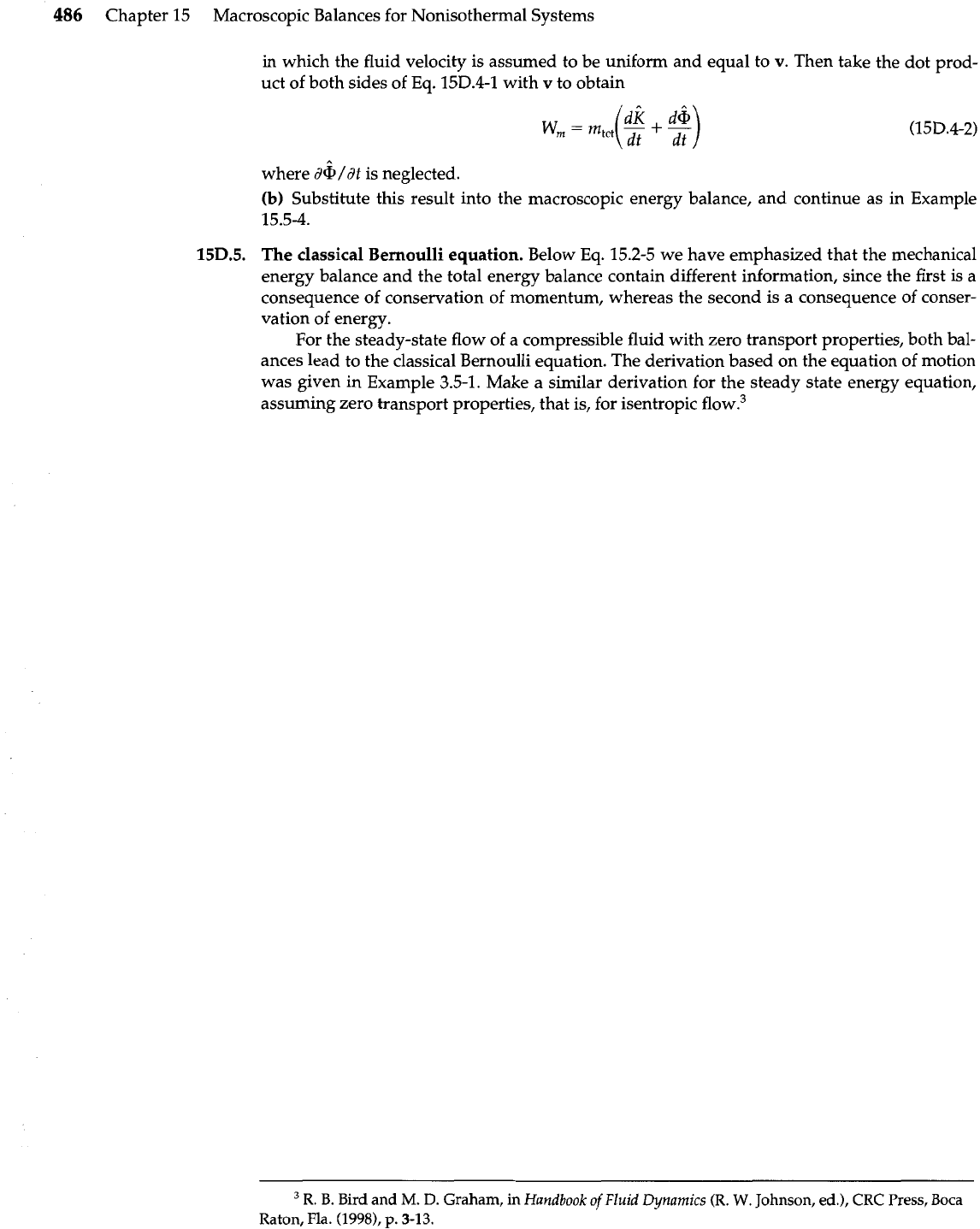
486
Chapter 15 Macroscopic Balances for Nonisothermal Systems
in which the fluid velocity is assumed to be uniform and equal to
v.
Then take the dot prod-
uct of both sides of Eq.
15D.4-1
with
v
to obtain
where
&/dl
is neglected.
(b)
Substitute this result into the macroscopic energy balance, and continue as in Example
15.5-4.
15D.5.
The
classical Bernoulli equation.
Below Eq. 15.2-5 we have emphasized that the mechanical
energy balance and the total energy balance contain different information, since the first is
a
consequence of conservation of momentum, whereas the second is a consequence of conser-
vation of energy.
For the steady-state flow of a compressible fluid with zero transport properties, both bal-
ances lead to the classical Bernoulli equation. The derivation based on the equation of motion
was given in Example 3.5-1. Make a similar derivation for the steady state energy equation,
assuming zero transport properties, that is, for isentropic flow.3
R.
B.
Bird and
M. D.
Graham, in
Handbook
of
Fluid Dynamics
(R.
W.
Johnson, ed.), CRC Press,
Boca
Raton,
Fla.
(19981,
p.
3-13.
